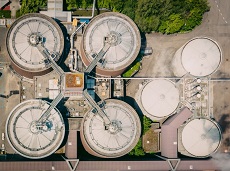
All life – human, animal, plant – depends on water. When water is used, it becomes unsuitable for human consumption until treated. Wastewater treatment processes reconstitute wastewater sufficiently to be discharged into the environment. It may go into a lake, river, or ocean, and it may irrigate land for agriculture or other uses. After it’s been sufficiently diluted and filtered through natural processes, a potable water treatment plant can further treat it for human consumption.
This article will discuss the treatment technologies most commonly used in wastewater treatment plants (WWTPs). These processes have been developed and refined over the last century, and new treatment methods are being discovered constantly. The processes we’ll look at are:
- Conventional activated sludge (AS, CAS) is one of the oldest technologies and is still used in many plants.
- Membrane bioreactor (MBR) is a more recently developed process and produces good-quality effluent.
- Moving bed biofilm reactor (MBBR) was developed in Norway in the 1980s and is used in about 700 plants worldwide.
- Integrated fixed-film activated sludge (MBBR IFAS, IFAS) is particularly efficient at nitrogen removal.
- Sequencing batch reactors (SBR) use a type of activated sludge system where the feedwater fills a tank and then is allowed to settle for a time after the initial anoxic and aeration stages.
Conventional Activated Sludge Process
This wastewater treatment process is partly aerobic (in the presence of oxygen) where microorganisms digest organic material in the wastewater. These organisms gather in flocs that easily settle out and can be removed mechanically.
Air is injected into the feedwater in an aeration tank. Then, in the “final clarifier” or “secondary settling tank,” the flocs are allowed to settle into a sludge blanket. The liquid and sludge mixture is referred to as “mixed liquor” until the sludge has settled. Additionally, it includes anoxic and anaerobic zones that remove nitrogen and phosphorus.
Some sludge from the process is returned to the plant inlet to re-seed the new feedwater entering the aeration tank. In 1913 two engineers conducting research at the Manchester (England) Corporation Rivers Department, Edward Ardern and W. T. Lockett, discovered the activated sludge process. The first full-scale continuous-flow plant using the activated sludge process was installed in Worcester in 1916. Over the next 20 years, the process became well-known in wastewater management circles.
Membrane Bioreactor Process
A membrane is a medium with selective transmissibility. Some material, like water, will pass easily through it, while undesirable components of the mixed liquor are trapped.
Advantages of this wastewater treatment process are:
- Good-quality effluent, suitable for direct discharge into environmental waters and uses such as irrigation and domestic greywater (non-potable household use).
- Small plant footprint – higher mixed liquor suspended solids concentrations can be processed, reducing the reactor volume needed.
- Easy retrofit for upgrading old WWTPs.
To keep river water this clean, MBR is useful technology – credit Amit Jain on Unsplash.com. There are two options for MBR wastewater treatment process configuration:
- Internal/submerged – the membranes are integral to the reactor and are submerged in the mixed liquor.
- External/sidestream – the membranes are in a separate unit. This option requires an additional pumping step in the process.
As MBR technology has improved and membrane material has become less expensive, this technology is finding a growing list of wastewater treatment process designers who prefer it.
Moving Bed Biofilm Reactor
This wastewater treatment process was invented in Norway by Hallvard Odegaardin the late 1980s. It uses an aeration tank with plastic carriers near the density of water that provide a large surface area for a biofilm to grow. A sieve on the outlet of the tank prevents the carriers from escaping.
Some advantages:
- Adding more carriers without building additional tanks can increase the capacity of a WWTP without adding to its footprint,
- Better nitrification with higher effective sludge retention time.
- No operator action necessary to react to load changes.
- Less sludge production.
- Small footprint.
- Toxic shock doesn’t upset it.
- No sludge return time improves process performance.
Integrated Fixed-Film Activated Sludge (IFAS) Bioreactors
This wastewater treatment process is a variation of the conventional activated sludge process. It includes fixed or movable carriers to improve the oxygen distribution in the activated sludge. Similar to the activated sludge systems, it requires secondary settling tanks.
The IFAS process is well-suited to the expansion or upgrade of existing systems and also can improve nitrification or nitrogen removal in existing activated sludge systems.
Sequencing batch reactors (SBR)
SBRs are a type of activated sludge process That can effectively treat sewage as well as anaerobic digester biomechanical treatment outputs. As the name implies, they treat influent in batches. The sequences in treating a batch are:
- Filling the tank and mechanically mixing the liquor anaerobically,
- Aerobic treatment – typically 60-90 minutes, depending on plant size and influent characteristics.
- Settling (equal to aeration time), and
- Drawing off the supernatant liquor.
The chemical processes involved are nitrification (conversion of nitrogen from reduced ammonia to oxidized nitrates/nitrites) and sometimes the addition of alum to remove phosphorus compounds. During settling, the aerobic bacteria consume the oxidized nitrogen after they’ve used up the dissolved oxygen. The result is harmless nitrogen gas.
As you can see, the options for wastewater treatment processes are many. We’ve touched on only a few here, and more are constantly being discovered. Here’s a more exhaustive, but still incomplete, list. To learn more about wastewater treatment plant design, talk to the experts at Transcend Water, a leader in the wastewater treatment software and plant design business for over ten years.
Related posts:






